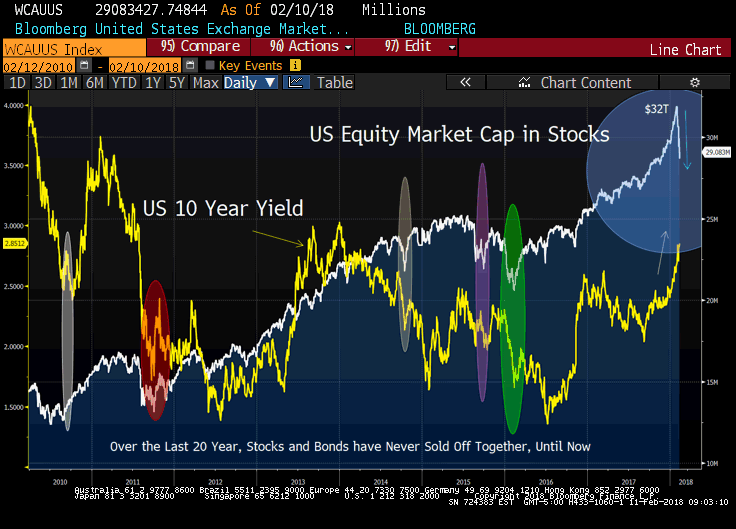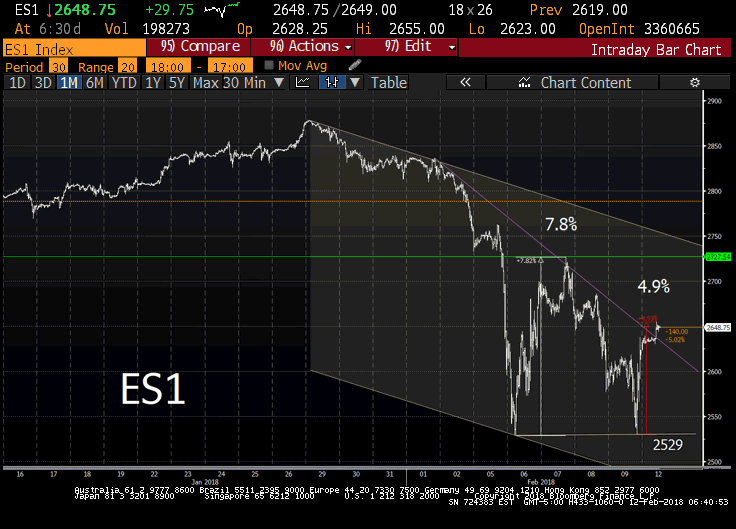Join our Larry McDonald on CNBC’s Trading Nation, Wednesday at 3:05pm ET
Pick up our latest report here:
Don’t miss our next trade idea. Get on the Bear Traps Report Today, click here“We believe inflation is set to finally pick up in 2018. Much of the passive and quant-side (a $1.5T shift in asset management) has become heavily invested in the “risk parity” model which involves being long equities and bonds on a risk-adjusted basis. One of the fundamental problems with this strategy is you’re effectively really long disinflation. Sure, it’s worked very well in the post great financial crisis period, but it’s a grossly crowded trade and has all the makings of a gruesome slaughterhouse. In this case, the risk tail is a period where equities and bonds fall together, which is not that uncommon in a late cycle inflationary environment (see 1980s and 1990s). Other than out of the money puts in rates (bonds) a big way for this crowd to hedge inflation is to increase commodity exposure. As long-time bulls, we’re now ‘pounding the table’ bond bears for 2018.”
Bear Traps Report, January 2, 2018
Think of the dentist in Cleveland, Ohio with $1M in stocks and $1M in bonds in a portfolio. For the first time in twenty years, he / she is looking at their brokerage statement and seeing NO wealth destruction OFFSET from bonds. Let us explain.
Bonds Protect Stocks, No More
 In the 70s and 80s this was very common – over 21 instances where stocks and bonds sold off together two weeks + (clearly inflation-driven). In the 90s only a few (3) instances, From 2000-2018 there had been nearly zero 2-3 periods where stocks and bonds moved lower together – UNTIL NOW. As you can see above. In the 2010, 2011, 2014, 2015 and 2016 equity market drawdowns – bonds rallied in a substantial fashion. In every “risk off” regime, it has been stocks DOWN – bonds UP for as far as the eye can see. This month, for the first time in nearly two decades, the negative correlation between stocks and bonds turned positive. This is a MAJOR game changer for the wealth management industry.
In the 70s and 80s this was very common – over 21 instances where stocks and bonds sold off together two weeks + (clearly inflation-driven). In the 90s only a few (3) instances, From 2000-2018 there had been nearly zero 2-3 periods where stocks and bonds moved lower together – UNTIL NOW. As you can see above. In the 2010, 2011, 2014, 2015 and 2016 equity market drawdowns – bonds rallied in a substantial fashion. In every “risk off” regime, it has been stocks DOWN – bonds UP for as far as the eye can see. This month, for the first time in nearly two decades, the negative correlation between stocks and bonds turned positive. This is a MAJOR game changer for the wealth management industry.
Twenty Year Lows
Investors cut bond market allocation to a 20-year low amid fears of a ‘crash’ – The recent market correction and spike on bond yields scared professional investors, according to the February Bank of America Merrill Lynch Fund Managers Survey. Investors sliced bond allocations to their lowest level since 1998, with a net 69 percent underweight fixed income. – CNBC
- US Treasury Federal Budget, Yearly Tax Receipts vs. National Debt
2017: $1.787T vs. $20.244T*
2007: $1.163T vs. $9.002T
US Treasury Data
*US debt to surge by $1T every year until 2022 under Trump budget.
Early Innings
When you think about the $1.5T of capital that’s flown into passive bond ETFs and risk parity strategies, this crowd has a colossal disinflation bet on. In a regime change, a period where stocks and bonds move lower together, the flight of assets out of passive bond risk parity will be ferocious. Then add the credit quality deterioration globally (AAA rated corporates / sovereign credits off 30-40% in terms of the amount of high-quality paper last 10 years). Then look at debt to GDP in G20 countries, up from 70% (ten years ago) to near 100% (maybe 110%) today. Next, look at the emerging market (EM) dollar-denominated debt issued 2007-2017, in the trillions. There’s a new EM player at the table trying to sell/refinance a large debt load. Next, look at the budget explosion out of Washington. The 2018 US budget deficit has ballooned from $700B (year-ago forecasts) to nearly $1.2T. All this speaks to a regime change. We believe we’re in the first or second inning, there’s a lot more to come. Stay tuned.
The 2529 Bounce

Fierce bulls are never taken down by one sword, this one has some fight left. So far we’ve seen two bounces (7.8% and 4.9%) off of 2529 in S&P 500 futures.
Largest US Equity Market Wealth Destruction
2008: -$10.5T
2015: -$4.5T
2011: -$3.7T
2018: -$3.2T**
2010: -$2.4T
*Last 10 years, Bloomberg US Market Capitalization data.
**Only instance in the last 18 years where bonds also lost value. As the ten-year Treasury bond surged in yield (2.02% to 2.85%), bonds have lost nearly $2T in value since September.
2008 Equity Drawdown
In the 2008 equity drawdown, bonds rallied from 4.22% to 2.05%, providing nearly $4T of positive cushion to offset the equity wealth destruction.
2015 Equity Drawdown
In the 2015 equity drawdown, bonds rallied from 2.44% to 1.35%, providing nearly $2.1T of positive cushion to offset the equity wealth destruction.
2011 Equity Drawdown
In the 2011 equity drawdown, bonds rallied from 3.42% to 1.74%, providing nearly $2.5T of positive cushion to offset the equity wealth destruction.
2010 Equity Drawdown
In the 2010 equity drawdown, bonds rallied from 3.92% to 2.82%, providing nearly $2T of positive cushion to offset the equity wealth destruction.
2018 Equity Drawdown
In the 2018 equity drawdown, bond SOLD OFF from 2.05% to 2.85%, ADDING nearly $1.4T of ADDITIONAL wealth destruction.
Pick up our latest report here:
Don’t miss our next trade idea. Get on the Bear Traps Report Today, click here

